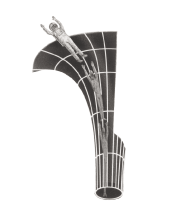Do all black holes have such strong tidal forces at such large distances from the event horizon? No, and this may sound odd, but the larger the mass of the black hole, the weaker the tidal forces will be! This seemingly paradoxical situation has a simple origin: the tidal force is proportional to the hole’s mass divided by the cube of its circumference. So as the mass grows and the horizon radius grows proportionally, the near-horizon tidal force actually decreases. For a black hole weighing a million solar masses, the tidal force is 10 billion times weaker than what they are for a 10 solar mass black hole.
Thus, it is most instructive, phenomenologically, to fall into a very massive black hole like the kind you would find in the center of an active galaxy. We will try to understand what happens both from the perspective of the one who is falling (which we will call the Explorer) and from the perspective of those watching from a safe distance away (which we will call the Watchers). The journey will appear to be completely different from those two perspectives, thanks to the amazing behavior of space and time in the clutches of a black hole's gravitational pull.
As our Explorer begins to fall toward the black hole, for the first few minutes of the journey nothing will appear out of the ordinary.

|
| Spaghettification |
Clocks on board our intrepid Explorer and on board the safe-distanced Watchers are in unison. Space is not distorted and the light coming from the Explorer is normal. As our Explorer approaches the event horizon, she begins to be stretched out because gravity is pulling more strongly on her feet than on her head. Although to our Explorer time is still running along in a normal fashion, the Watchers now see her clock running slow. The strong gravity of the black hole is now distorting both space and time. The Watchers also notice that the Explorer now appears to look redder than normal, as light loses energy in its struggle with gravity to pull away from the hole. Just above the event horizon, the elongated Explorer is almost invisible. The light has become extremely red and dim as it loses most of its energy in its fight with gravity. Amazingly, the Watchers never see the Explorer fall into the black hole. Because time runs slower and slower near the hole, she never appears to cross the event horizon, but seems to hover just above it for infinite time. The experience, however, is quite different for the Explorer, who feels herself being pulled faster and faster into the black hole. As she crosses the event horizon, the black void is suddenly replaced by an unimaginable array of views. We do not know what she may see inside the black hole and, unfortunately, she can never communicate her discoveries back to the Watchers. Within a few seconds, she is swept into the singularity.



Download a pdf version.





